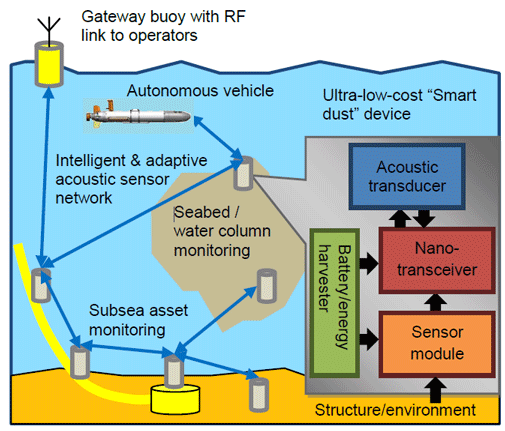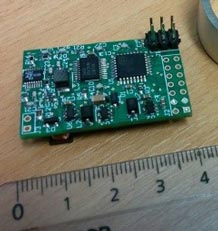Smart Dust for Large Scale Underwater Wireless Sensing
EPSRC USMART
Wireless sensor networks using radio technology are used to gather data in many applications for infrastructure monitoring, environment monitoring and security. However this technology cannot be directly applied under water since radio waves are absorbed by water. Technologies exist for underwater communication using acoustic waves (sound) to carry data but this is a complex and demanding task requiring sophisticated processing. Hence these devices are expensive (£5-20k), bulky and power hungry which has generally limited their use to relatively small numbers and short duration. This has prevented the large scale deployment of sensor networks underwater despite huge demand for monitoring of subsea assets and the marine environment.
The aim of this project is to create a smart underwater sensing framework based on ultra-low-cost underwater communication and sensing devices ('smart dust'). Pilot studies at Newcastle University have demonstrated the feasibility of producing underwater acoustic communication devices known as "nanomodems" which use novel approaches to signal processing to vastly reduce hardware complexity, size and cost. These have manufacturing cost as low as £50, very low receiver power consumption, to enable long life from small batteries, and tiny dimensions. However they can achieve data transfer and positioning capabilities found in much more expensive devices, over distances up to 1km through water.
To maximise the impact of the project, an open test-bed will be created near the Northumberland coast. Potential end-users from across the subsea sector will be invited to take part in a series of workshops to identify new opportunities in distributed underwater sensing, which will be prototyped and evaluated via trials using the test-bed. The ultimate measurable objective of the project will be to demonstrate a step change in the efficiency of subsea data gathering. This will be defined in terms of the data delivered (volume, quality, coverage) versus overall cost of operations (hardware cost, boat time, staff time, infrastructure cost).
Key objectives
- The communication technology will be extended, to further increase data transfer speed and power efficiency.
- Low cost sensor modules will be developed, along with flexible interfaces for commercially available sensors, to create mass deployable wireless underwater sensor devices.
- Protocols will be developed to allow large numbers of units to share the same communication channel efficiently.
- Intelligent sensor processing techniques will ensure that the sensor network reliably extracts the maximum information available from the limited resources available.
Expected outcomes
- The system will allow users to fully exploit the power of mass deployment, the whole being far greater than the sum of the parts. This will transform underwater sensor networks to allow long term monitoring with high spatial resolution, frequent updates and near real-time data delivery in a way that has been previously been cost prohibitive and impractical.
- With highly flexible sensor payload, the technology created may be applied to a wide range of monitoring tasks. However, the project will focus on three main demonstrator scenarios in close collaboration with industry & end users:
- Subsea asset monitoring eg, condition of subsea cables, risers, seabed installations.
- Marine environment / biodiversity monitoring - chemical or biological parameters.
- Sensor nets for underwater security - detecting sound emitted or magnetic disturbances from underwater threats.
Novel contributions
- Disruptive, low-cost technology enabling mass deployment with battery life of several years.
- Large scale underwater monitoring (>100 devices) with high spatial resolution.
- Rapid deployment and online data delivery (as opposed to data logging and collecting later).
- Intelligent, adaptive sensing to maximise resource utilisation and fully exploit large scale.
Example deployment scenario


Newcastle University’s Nanomodem (SEAlab Newcastle)
Members
- Paul Mitchell
- Yuriy Zakharov
- Nils Morozs
Funding
- EPSRC
Dates
- June 2017 to May 2020
Partners
- Newcastle University (lead partner), Principal Investigator: Jeff Neasham
- Heriot-Watt University
- University of York
- Proserv (Nautronix)
- Subsea 7 Limited
- TECHNIP-COFLEXIP UK HOLDINGS LIMITED
Research
